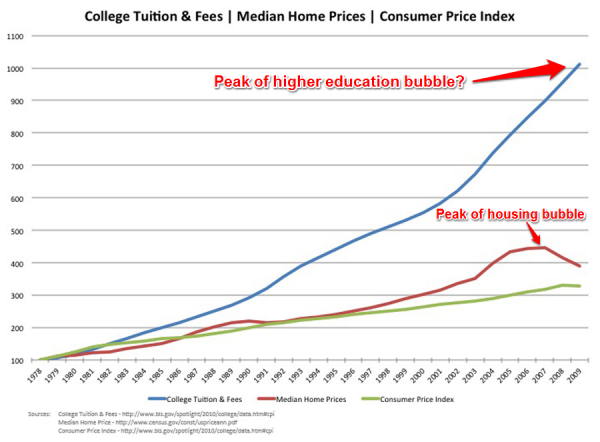20 years from now, people who grossly overpaid for their bricks & mortar college experience and are still paying off their massive student loans, will feel like incredible chumps.
Looking at families digging deep into their pockets to pay exorbitant college tuition, this same thought has crossed my mind. As college administrators ponder the rough road ahead, Stuart Butler of the Brookings Institution advises that it will take more than a few tweaks for some institutions to survive the coming years.
… if today’s college leaders—even at the Ivies—believe they can merely tweak their business models to carry them into the future, then they are in for an even more unpleasant surprise. They should ponder the still recent experience of the music industry, film and television, booksellers, and news media. If they did, they would soon recognize that the higher education industry is encountering a multi-pronged and existential threat composed of successive waves of disruptive innovation. This disruption will force top-to-bottom changes in the very concept of higher education and its relationship with the broader economy.
Butler sees a pattern affecting many industries, including higher education.
1. The underserved consumers are targeted first, “leaving the upstarts to occupy a sector of the market of little interest to industry leaders”. Online news aggregators looked to “young people with distinct tastes and only casual interest in the news”.
…Early versions of online courses appealed to students who could not easily maintain a regular schedule, or who needed more time to understand material….
2. The initial product is substandard.
… The Apple I, introduced in 1976, hardly seemed a harbinger of doom to the managers of IBM’s mainframe monsters. So it is no surprise today to read college presidents denigrating MOOCs and the cheap, no-frills degrees being rolled out in Texas and Florida….
3. Episodes of adaptation and refinement occur amid harsh criticism.
… The clunky Apple I sold just a couple hundred units, but the elegant Macintosh, introduced twenty years later, ransacked the computing industry.
That’s why the shortcomings of MOOCs today should be of little comfort to the higher education establishment….
4. Unbundling is to be expected, as both hospitals and newspapers have discovered.
As with hospitals and newspapers, bricks-and-mortar institutions of higher education are particularly vulnerable to unbundling. Universities are modular institutions, and lower-cost competitors can easily siphon off customers and revenue from individual modules. For instance, universities are partly a hotel and food service industry, and partly sports and entertainment centers. They have invested heavily in buildings and services that package these elements together at essentially one price. But this makes them vulnerable to competitors that find much less expensive ways to provide discrete modules like housing or even basic first-year classes—or that simply shed costly facilities like libraries or student centers, as online colleges have done.
While credentials are highly valued, academic information is priced at nearly zero.
Indeed, the most challenging and decisive feature of unbundling and competition for the low-cost parts of the college bundle of services comes from the fact that the price of academic information is falling nearly to zero. Why pay a ton of money to sit with 300 other freshmen, listening to a Nobel Prize winner you will never actually meet on campus, when you have access to everything he has written, maybe even video versions of his lectures, free of charge on the internet?…
Even the social part of college can be unbundled.
But what about the social “college experience”? Well maybe that can be unbundled, too. Does undergraduate college have to last four years, or could the residential, networking, or sports elements occupy just part of the period of study at much less total cost? Britain’s Open University has for years brought students on campus for just a few weeks each year. It retains a similar model today using online classes instead of its original televised courses. Yet it is number three in the UK for student satisfaction, tied with Oxford. Moreover, for many young people today online networking provides the relationship of choice for professional purposes, not just for social life. For them, Facebook, LinkedIn, and texting can be a more efficient and even more personal way of building and maintaining future career contacts than paying for a dorm or hanging out at a college gym.
How should universities respond? Brooks recommends that they need to “price discriminate” in a way that supports what they are selling. And “they will have to determine their true competitive advantage”. So some schools, Ivies and other elite institutions, will be able to maintain high prices for the exclusive campus experience they are selling. Other schools will drop their prices for the cut-rate learning experience they provide.
How should families respond? Butler’s forecast is consistent with other predictions of sharper class distinctions and a ‘growing bifurcation between elite universities and “trade schools”‘. So families should be careful about paying premium prices today for what may be heavily discounted 20 years from now.
———
Stuart Butler, “Tottering Ivory Towers”, The American Interest, August 11, 2014.

